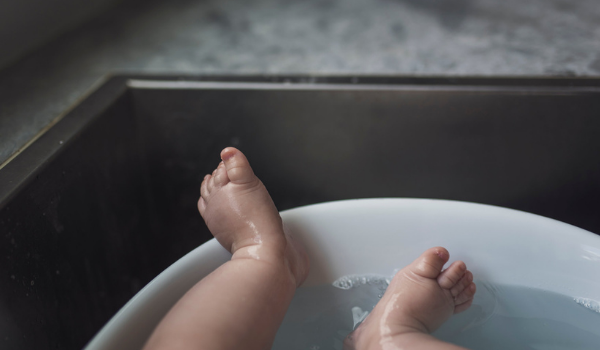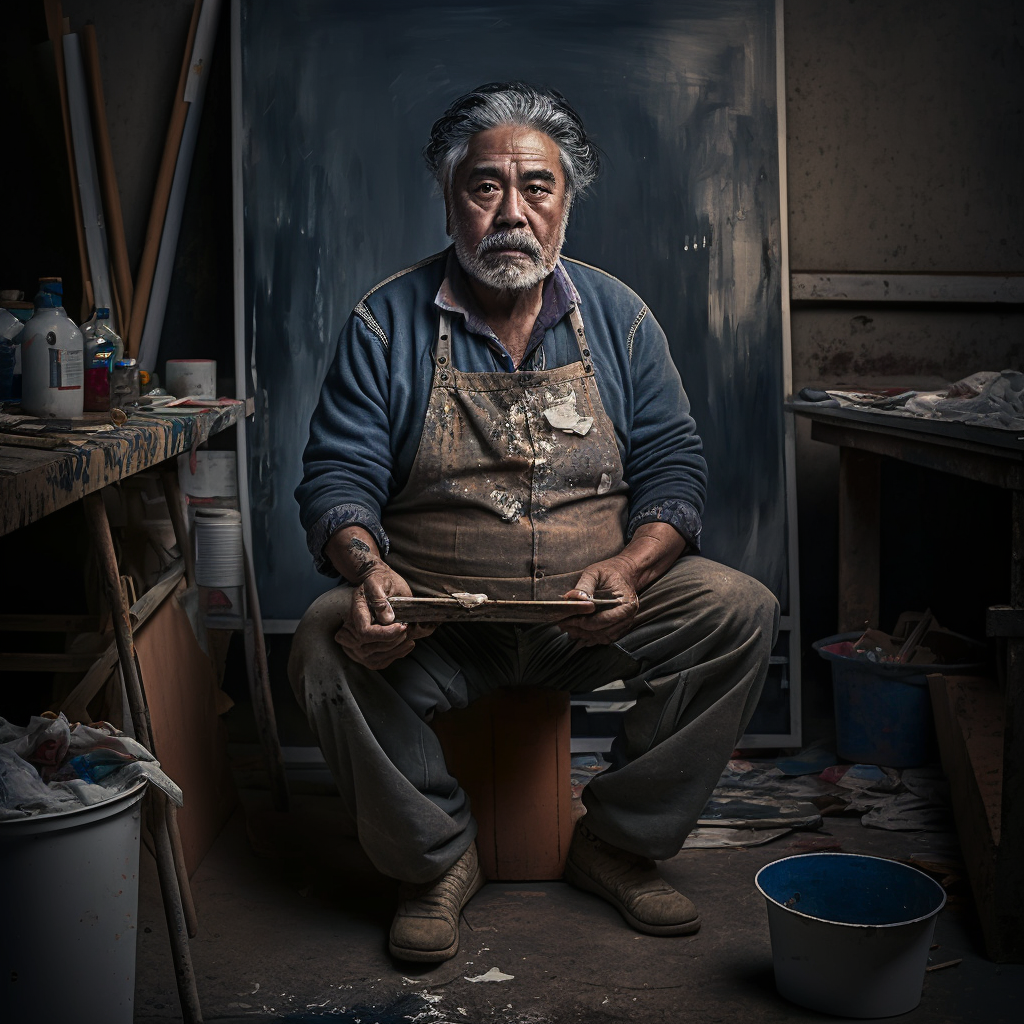Randy Charles is the owner of PaintCentric.com, a website dedicated to providing information, tips, tricks, and news about all things paint. With over 10 years...Read more
Creating keepsakes with your baby’s handprints and footprints can be a fun activity, but safety is key. Acrylic paint is popular for its durability and vibrant colors on various surfaces.
In this article, we’ll dive into whether it’s safe for your little one’s skin and explore safer alternatives that offer peace of mind without sacrificing quality. Keep reading to ensure those tiny prints are made safely!
What Type Of Paint Is Safe For Babies?
As mentioned above, acrylic craft paints could cause a skin irritation or reaction. Likewise, paints used for walls and outdoor painting should be avoided, not just because of the chemicals, but the VOCs could affect the child’s breathing.

The good news is there are a variety of safe choices for people to use on their baby.
Finger paint
Finger paint is a fun and unique way for your toddler to express her artistic talents. Due to its ingredients, finger paints themselves don’t pose any special health hazards (aside from the occasional mess on the floor), making it a safe paint.
Still, not all paints are created equal, so it’s important to find the kind that’s best suited to your baby’s age and activity level, whether painting on your baby’s foot or having your child paint for themselves.
Tempera paint
Tempera paints are ideal for small children as they is non-toxic and washable. Tempera paint is made of pigments (coloring agents) mixed with either casein (a milk derivative) or soap, making it safe for baby footprints.
It is a vibrant paint, and kids love the endless possibilities Tempera provides when different colors are mixed. These paints can be used in many ways and are great for anything from feet painting to finger-painting.
Another feature is its great staying power. Its compounds keep it from fading easily. It makes Tempera perfect for painting on a variety of materials, such as paper, cardboard, stone, and canvas. Many artists prefer tempera as their main medium because it is opaque and resists fading and weathering.
Activity paint
Another paint you can consider using on your babies is the activity paint. The paint is common during the festive period, and you mostly see it on kids’ faces and hands with different decoration styles.
To use on your baby, you should check the label and all that is written on the paint before using it. Some manufacturer instructs how to use it and ways to clean it off the body.
Watercolor paint
Without a doubt, watercolor paint is the best to consider for your baby. I grew up knowing that watercolor paint is not toxic and safe to use for all kinds of applications.
Apart from the fact that it is non-toxic, the paint can easily wash off. All you need to do is get your baby’s hand or feet into any bowl filled with water and gently wash off the paint. It is as simple as that. It is the common paint you see on babies’ faces during the Christmas season.
DIY Paint
You can also choose to make your own paint. Check out the link below for a step-by-step tutorial.
Is Acrylic Paint Safe For Baby Foot And Handprints?
No, I would not suggest or advise that you use acrylic paint for your handprint painting. Kids from age five and above might have a skin texture that can stand up against the chemical in the paint even if it is said to be non-toxic acrylic paint, but it still is recommended to use the paint types listed above.

However, babies skin is delicate and might not handle the effect that comes from acrylic paint. If you ever want to use acrylic paint on your baby, you should ensure it doesnt stay long on the foot or hand. You should wash it off immediately to avoid any complications in the future.
Overall, it is not safe to use on your babies. Other paints are safe to use for your baby’s handprint art. You just need to get to the paint store and request ones you can use on your babies without any hassles or issues.
Alternatives to Acrylic Paint for Baby Prints
Explore other safe options for creating baby prints, such as washable tempera paints, water-based paint options, and homemade finger paint recipes.
Washable Tempera Paints
Washable tempera paints are great for little hands and feet. They are non-toxic, which means they are safe for babies to use. Parents like them because they are easy to clean up. If paint gets on clothes or furniture, it usually comes off with water.
Little artists can have fun without making a big mess.
After using washable tempera paints, you might want to try other kinds of paint that are also safe for kids.
Water-Based Paint Options
Water-based paints, like watercolors and washable tempera paints, are the safest choice for baby footprints and handprints. These paints are non-toxic, making them gentle on sensitive baby skin.
They can be easily cleaned with soapy water if any accidental messes occur during the crafting process. When creating keepsakes with baby prints, opt for these water-based options to ensure a safe and enjoyable crafting experience.
For those wanting to embark on a more adventurous path of creativity, homemade finger paint recipes using ingredients like baby oil or vegetable oil provide an engaging alternative while ensuring the safety of your little one.
Homemade Finger Paint Recipes
Create homemade finger paint using edible ingredients like flour, water, and food coloring. Parents may choose this option for children with allergies or sensitive skin. Recipes often include cornstarch, cold and boiling water, and food coloring to make natural and edible paint for babies.
Parents can also consider using Beech-Nut purées as an alternative to store-bought options when making homemade finger paint. This provides a safe and enjoyable activity for children while avoiding potential allergens or irritants found in some commercial products.
Moving on to the next section on “Safe Application of Paint for Baby Prints,” let’s explore the precautionary measures and steps for safely applying paint for baby prints.
How To Do Baby Handprints And Footprints With Paint At Home?
The perfect way you can go about painting your baby’s hand prints at home is to have all necessary things set aside with a specific place for the experiment. The ground likely gets dirty due to spills or splashes of the paint. So, you should get it done in your garage or an open place.

Mix your paint
The first step is to mix your paint and ensure it is ready for the experiment or painting task.
Get a bowl and pour the paint
The next task is to get a bowl that is big enough to accommodate your baby’s hands and foot. You should pour the paint there and get ready for the next task.
Get the canvas or paper prepared
If your primary aim of painting your baby’s hand and foot is to get the handprints and footprints, you should get your canvas ready or the paper/cardboard you intend to frame.
Insert the foot and/or hand in the paint
The next task requires lots of patience because it can be quite hard sometimes to control the movement of babies.
You should carry your baby and gently immerse the hands in the paint while you wear gloves. Remove your baby hand from the bowl of paint and stamp the hands on the canvas for some minutes. Try to apply even pressure to the surface so the hand and foot creases still show through.
After that, you should remove the hand from the canvas or paper. You should do the same for your baby foot. By now, you should have the baby’s hand print and the footprint on your page.
Wash off
The last task for you is to wash off the paint from your baby’s hands and foot. If you have any stains on you during the process, you should wash yourself too and keep all paints away from your baby.
How Do I Remove Paint From My Baby’s Skin?
The process of removing paint from your baby’s skin is so easy. Just follow the step below.

Get a bowl with warm water
You just get a bowl with lukewarm water. You should immerse the hand and foot of your baby and wash off the paint from the skin. You can use a soft brush for paints that are stubborn to come off the skin. Also, you might choose to use baby soap if there is a need for it.
Use a clean towel
Once you are through with washing off the paint from your baby skin, you should wipe dry the hands and foot using clean towels. After that, you can apply a small amount of baby lotion or a bit of baby oil on the hand.
Related: Is Acrylic Paint Safe for Aquariums?
Final Thoughts
Is acrylic paint safe for baby foot and handprints? Acrylic paint is most often used for art and crafts. However, it should not be considered for a baby’s handprint and footprints. It contains some chemicals that are not safe for babies even when claimed that it is non-toxic.
The best decision as a concerned parent is to get a paint that is baby safe. With some planning, you will be able to enjoy both the process and the outcome of your handprint craft.

Randy Charles is the owner of PaintCentric.com, a website dedicated to providing information, tips, tricks, and news about all things paint. With over 10 years of experience in the painting industry, Randy has become an expert in the field and is passionate about helping others learn more about painting. He has written numerous articles on the subject and is committed to providing accurate and up-to-date information to his readers.
- Latest Posts by Randy Charles
-
How Much Do You Tip Painters? The Ultimate Guide
- -
Can You Paint Over Rust Converter?
- -
Can You Paint Inside When It Is Raining?
- All Posts
